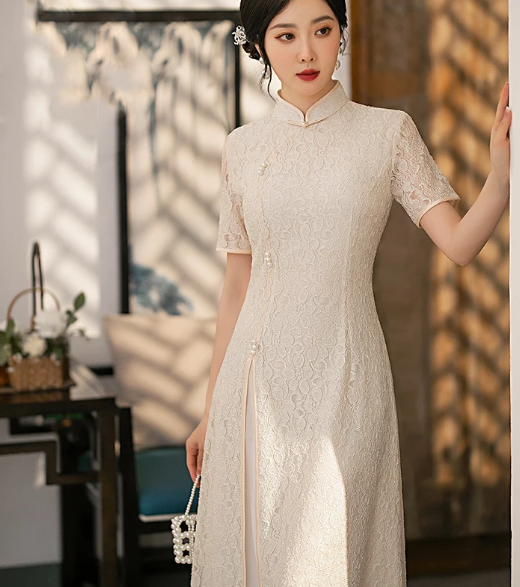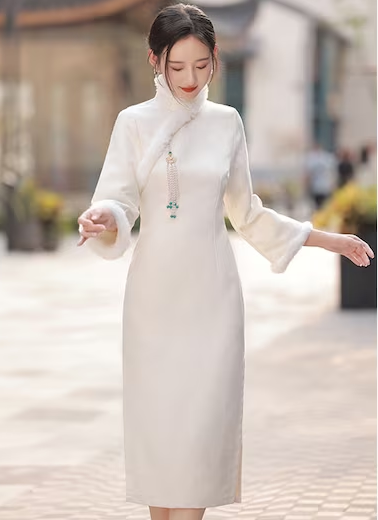Historical Significance of the Cheongsam
The cheongsam, a quintessential emblem of Chinese fashion, has traversed a remarkable journey through history. Originating in the 17th century, it initially reflected the Manchu ethnic clothing. Over time, the cheongsam evolved, assimilating elements from various dynasties and regions. This evolution symbolizes the dynamic and interwoven history of China.
Origin and Evolution
In its earliest form, the cheongsam, known as “qipao” in Mandarin, was loose and covered most of the body, reflecting modesty and traditional values. The transformation in the 1920s and 1930s marked a significant shift. Women in cosmopolitan areas like Shanghai adopted a more form-fitting style, which signified not only a fashion statement but also a silent rebellion against traditional norms. This version highlighted the elegance and grace of the female form, contrasting with earlier conservative styles.

Cultural Impact in Different Eras
Throughout different eras, the cheongsam has been a canvas reflecting broader cultural changes. In the early 20th century, it symbolized liberation and modernity for Chinese women. However, during the Cultural Revolution, its popularity declined, as it was seen as a representation of bourgeois decadence. In recent years, there has been a resurgence of interest in the cheongsam, with designers integrating contemporary elements into its traditional form. This modern adaptation serves as a bridge between China’s rich historical past and its rapidly evolving present.
Symbolism of the Color White in Chinese Culture
The color white holds profound symbolic meanings in Chinese culture, woven intricately into the fabric of history and society. Unlike Western associations of purity and innocence, white in Chinese tradition often represents mourning, death, and reverence for ancestors. This dichotomy highlights the fascinating ways cultures diverge in symbolism.
Traditional Interpretations
Traditionally, white has played a central role in Chinese funerals and mourning rituals. It symbolizes the departure from life and respect for the deceased. In ancient times, mourners would wear white clothes as a sign of their grief and longing for the departed. This practice underscores a deep-rooted cultural reverence for ancestors and the afterlife.
Contemporary Meanings
In contemporary China, the color white has begun to adopt more diverse and positive connotations. It is increasingly associated with modernity, simplicity, and minimalism, reflecting the country’s rapid urbanization and evolving fashion trends. Younger generations, influenced by global aesthetics, are embracing white in their wardrobes and lifestyles, signifying a shift from traditional to more modern interpretations.
Fashion and Aesthetics of the White Cheongsam
The white cheongsam stands as a timeless symbol of elegance and sophistication in the realm of fashion. Its unique blend of traditional Chinese aesthetics with modern sensibilities has made it an iconic garment, revered both within and beyond Chinese culture. The white cheongsam not only encapsulates beauty but also tells a story of cultural fusion and evolution.
Design Elements and Styles
The essence of the white cheongsam lies in its distinct design elements. Its high collar, form-fitting silhouette, and side slits combine to create a look that is both modest and alluring. The use of white fabric adds a layer of subtlety and grace, making the dress suitable for various occasions. Designers often incorporate intricate embroideries or patterns, which add depth and cultural significance to the garment. These elements make the white cheongsam a versatile piece, blending traditional Chinese craftsmanship with contemporary fashion trends.
Influence on Modern Fashion
The influence of the white cheongsam in modern fashion is undeniable. It has inspired designers worldwide, leading to adaptations and reinterpretations in various fashion lines. The cheongsam’s elegant silhouette and symbolic significance have made it a popular choice for formal wear, themed events, and even as a source of inspiration for wedding dresses. Its impact extends to the global fashion scene, where it is celebrated as a representation of cultural heritage and timeless style.
The White Cheongsam in Literature and Cinema
The white cheongsam has carved a unique niche in the realms of literature and cinema, symbolizing various themes and emotions. Its presence in these mediums goes beyond mere fashion, embodying cultural identity, social status, and even psychological nuances. The garment’s elegance and historical significance have made it a compelling element in storytelling.
Representation in Classic Literature
In classic literature, the white cheongsam often appears as a symbol of grace, femininity, and social change. Renowned novels like Eileen Chang’s “Love in a Fallen City” showcase characters donning the cheongsam, reflecting the evolving status of women in society. These literary works use the garment as a narrative tool to depict the inner lives and social environments of their characters, often set against the backdrop of significant historical events. The white cheongsam in these stories is not just attire but a narrative device that adds depth and context.
Iconic Appearances in Films
In cinema, the white cheongsam has made numerous iconic appearances, often becoming a visual shorthand for elegance and mystique. Films like Wong Kar-wai’s “In the Mood for Love” feature the cheongsam prominently, using it to evoke a sense of nostalgia and unspoken emotions. The garment’s aesthetic appeal combined with its cultural connotations lends a unique visual and symbolic dimension to film narratives. It bridges the gap between the traditional and the modern, making it a timeless piece in the cinematic wardrobe.
Socio-cultural Perspectives on the White Cheongsam
The white cheongsam, more than a mere fashion statement, is a rich tapestry of socio-cultural significance. It encapsulates various aspects of Chinese society, from gender roles to social status, and mirrors the changing perceptions over time. This garment serves as a lens through which the evolving cultural and social dynamics of China can be observed.
Gender and Social Status
Historically, the cheongsam was a symbol of femininity and elegance, often associated with higher social echelons. It represented a woman’s grace and social standing, particularly in urban settings like Shanghai. In these contexts, wearing a cheongsam signified a blend of modernity and adherence to cultural roots. However, the garment also played a role in the women’s liberation movement in China, symbolizing a break from traditional constraints and a step towards modernity and self-expression.

Changing Perceptions Over Time
Over the decades, perceptions of the white cheongsam have undergone significant transformations. Once a daily wear for women, it gradually became a garment for special occasions and formal events. In contemporary China, the cheongsam is often seen as a cultural relic, cherished for its aesthetic value and historical significance. However, it has also experienced a revival as a symbol of cultural pride and identity, especially among younger generations who view it as a fusion of tradition and modern fashion sensibilities.
The White Cheongsam in Global Context
The white cheongsam, a garment deeply rooted in Chinese culture, has made significant inroads into the global fashion landscape. Its journey from the streets of Shanghai to the world stage is a testament to its timeless appeal and versatility. This garment has not only become a fashion icon but also a bridge between cultures, illustrating the fluidity and interconnectedness of global fashion trends.
Adoption and Adaptation Worldwide
The cheongsam’s adoption beyond China’s borders showcases its universal appeal. Designers around the world have been inspired by its elegance and have adapted it to suit diverse tastes and cultural contexts. In Western fashion, elements of the cheongsam, such as the mandarin collar and sleek silhouette, have been incorporated into various clothing styles. This adaptation has allowed the cheongsam to transcend its traditional boundaries, making it a staple in the global fashion dialogue.
Cross-cultural Exchanges and Influences
The cheongsam’s global journey has also facilitated cross-cultural exchanges. It serves as a cultural ambassador, introducing elements of Chinese art and aesthetics to a broader audience. The garment’s influence can be seen in international fashion shows and collaborations, where designers blend the cheongsam’s traditional elements with contemporary trends. These exchanges have not only enriched the global fashion scene but have also fostered a deeper appreciation and understanding of Chinese cultural heritage.







